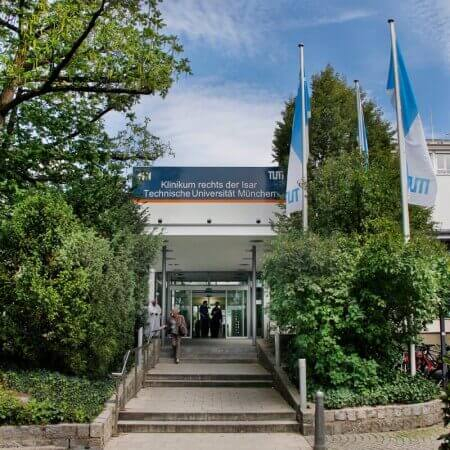The vitreous body is a gelatinous mass without vessels, which accounts for two-thirds of the volume of the eyeball. The destruction of the vitreous body is a change in its homogenous structure with the appearance of floating opacities. This is a common eye disease that is detected in 5% of people under the age of 40 years. According to instrumental diagnostics, the prevalence increases to 80% over 60 years. The cause of destruction is the appearance of fibers from the connective tissue inside the vitreous body. Doctors in Germany successfully treat the disease using safe minimally invasive techniques.
Content
- What is destruction of the vitreous body?
- Vitrectomy
- YAG laser vitreolysis
The main treatment methods for vitreous destruction are vitreolysis and vitrectomy. Doctors can remove the vitreous or destroy the opacities with a laser. In Germany, the procedures are performed with almost 100% efficiency and minimal risk of complications.
You can undergo treatment in the following hospitals: University Hospital Rechts der Isar Munich, University Hospital Ulm, Charite University Hospital Berlin.
Please leave your request on the Booking Health website, and we will help you choose the best treatment method, clinic and doctor. The specialists of the Booking Health company will hold a consultation with you on the medical aspects of the trip, and travel managers will fully take care of all arrangements.
What is destruction of the vitreous body?
The vitreous body is an extracellular matrix consisting of 98% water and macromolecules. The main ones are hyaluronate and collagen. In appearance, the vitreous body resembles a viscous gel.
In children, the vitreous body is homogeneous and transparent. As they grow older, it becomes cloudy, degrades, and opaque inclusions appear inside. This results from aging, inflammatory processes, dystrophy, diabetic vitreopathy or myopia. Aging also causes separation of the posterior vitreous from its attachment to the inner retinal border membrane.
Due to the changes described above, a person has "flying flies" of the vitreous body – opacities that cast a shadow on the retina and impair vision. Linear, circular, or nodal patterns appear before the eyes and move with eye and head movements.
Destruction of the vitreous body does not threaten complications and does not lead to vision loss. If a person can adapt to floaters, then they may not be treated. However, cloudiness will not disappear on its own, and there are no drugs that can "dissolve" them. Therefore, if the destruction of the vitreous body causes discomfort in a person, invasive procedures and operations are necessary to eliminate opacities.
Vitrectomy
Vitrectomy is considered the primary treatment for severe vitreous destruction. The operation was developed in the second half of the twentieth century. Previously, it required an incision several millimeters long, hemorrhage often developed, and sutures had to be applied. As of today, vitrectomy has become less traumatic, as doctors in modern eye clinics perform it using micro-invasive technologies.
The essence of the operation is that the vitreous body is completely removed. It is replaced with a gas mixture, silicone oil, and water with fluorine. They are used as plugging agents that press the retina of the eye to the choroid. Over time, the introduced artificial substances are absorbed and replaced by natural intraocular fluid.
After surgery, the patient may be prescribed antibiotics and drugs to prevent thrombotic complications or bleeding. Doctors measure intraocular pressure to make sure there are no complications. Rehabilitation takes about 1 week, and the final results of the operation can be assessed in 2-3 months.
YAG laser vitreolysis
In recent years, neodymium-doped yttrium aluminum garnet (YAG) laser has been increasingly used instead of conventional surgical treatment for the destruction of the vitreous body. It is a fast, inexpensive and sparing treatment method.
The technique provides good functional outcomes: visual acuity increases in patients after the procedure, and floating opacities disappear. Most treated patients do not develop any complications, but the procedure is not indicated for patients with open-angle glaucoma.
Studies show that patients with Weiss rings benefit the most from the procedure. These are large ring-shaped opacities that are signs of vitreous detachment.
The laser procedure for the destruction of opacities takes place on an outpatient basis, lasts about 20 minutes and does not require rehabilitation. The doctor evaporates the opacities, turning it into gas. Vision improves immediately after the procedure. In some patients, small spots and opacities remain for several days or weeks, which gradually disappear.
With the destruction of the vitreous body, you can use the services of the best doctors in the world. You are welcome to undergo the diagnostics and treatment of vitreous destruction in Germany by booking the medical care program via the Booking Health service. On our website, you can find the cost of treatment in different clinics in Germany and compare the prices. The price will be lower for you due to the lack of additional coefficients for foreign patients. The specialists of the Booking Health company will select the best clinic specializing in the treatment of vitreous body destruction and arrange your trip to Germany.
Authors:
This article was edited by medical experts, board-certified doctors Dr. Nadezhda Ivanisova, and Dr. Bohdan Mykhalniuk. For the treatment of the conditions referred to in the article, you must consult a doctor; the information in the article is not intended for self-medication!
Our editorial policy, which details our commitment to accuracy and transparency, is available here. Click this link to review our policies.
Sources:
Ophthalmology Times
British Journal of Ophthalmology
National Library of Medicine
















